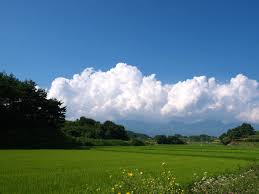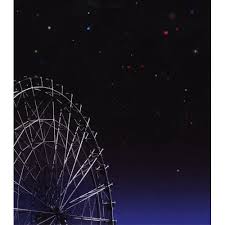- continued from yesterday
Spring is the season of birth, and summer is the time that lives born in spring enjoy their prosperity.
Plants, insects, and animals feel the spirit of each life to a great extent in a summer season.

If expressed in the life of a tree, it's the time of a "young tree".
It absorbs a lot of water and nutrition from the ground, and grows up high in the sky - tall and big.
The trunk looks glossy and fresh leaves grow thick showing its strong vitality.
It is probably something called "spirit" that we feel standing close to the tree.
When autumn comes, deciduous trees change the colour of leaves from green to red or yellow, and fall onto the ground.
Grasses fade its colour from fresh green to brownish dry green, and they are flown in a cold wind.
Insects finish their short season of love, and die quietly under grasses without anyone knowing it.

Autumn is the time that we have this helpless feeling of sadness and sorrow to the short-lives.
Even though autumn has a lot of aspects, and it is considered as a season of good harvests, book reading, and good appetite (there are many tasty food in autumn in Japan!), the feeling of sadness must be the common one among Japanese people, I believe.
Patrick Lafcadio Hearn (27 June 1850 – 26 September 1904), also known as Koizumi Yakumo (小泉八雲) wrote a beautiful essay on the cosmology of little lives, called "Insect-Musicians" (Exotics and Retropestives, 1898), "Mushi no Ongakuka"虫の音楽家 in Japanese.
The transition from the end of summer to autumn is described through insects gracefully and delicately by Hearn, and I strongly recommend this book to those who are willing for further reading.
Good for both Japanese and non-Japanese.
Exotics and Retropestives by Patric Lafcadio Hearn

This kind of feeling can naturally and sentimentally remembered when watching the last fireworks.
For children, fun-filled summer holiday is coming towards the end, and the new term will start soon in autumn.
We also remember a bit of sad feeling of childhood, too, maybe even we are already grown-ups.
And when the last of last fireworks are over, the night sky looks awfully dark and broad with white smoke floating in the air, and the clamour of impatient crowds rushing homeward bound and the feeling of sadness complicatedly mixed up.
This is merely my personal opinion, so it can't be said the feeling described above is a typical of Japanese people's when watching the last fireworks.
Each listener has his/her own personal memory coming up in mind, and listens to the song through his/her own projection.
But this is the truth that many of us have deeply moved by this song.

BANK BAND, one of rock bands which consists of top-flight musicians in Japan, copied this song, "Wakamono No Subete" (All About Youth) and released in June this year.
It recorded the 6th position in the Album Ranking of Oricon Chart (See this Wiki to find out what Oricon Chart is) in July 2010, and 120,000 CDs have been sold so far.
It is a very good news for Fujifabric fans as this simply means at least 120,000 people have listened to this song!
But, please remember, that was originally the song of Fujifabric's!!
I wish that people all around the world also get a chance to listen to this song, and share this feeling with us.
"Wakamono No Subete" (All About Youth) by Fujifabric
(English Lyrics is available in Lyrics on the right!)
Spring is the season of birth, and summer is the time that lives born in spring enjoy their prosperity.
Plants, insects, and animals feel the spirit of each life to a great extent in a summer season.
If expressed in the life of a tree, it's the time of a "young tree".
It absorbs a lot of water and nutrition from the ground, and grows up high in the sky - tall and big.
The trunk looks glossy and fresh leaves grow thick showing its strong vitality.
It is probably something called "spirit" that we feel standing close to the tree.
When autumn comes, deciduous trees change the colour of leaves from green to red or yellow, and fall onto the ground.
Grasses fade its colour from fresh green to brownish dry green, and they are flown in a cold wind.
Insects finish their short season of love, and die quietly under grasses without anyone knowing it.

Autumn is the time that we have this helpless feeling of sadness and sorrow to the short-lives.
Even though autumn has a lot of aspects, and it is considered as a season of good harvests, book reading, and good appetite (there are many tasty food in autumn in Japan!), the feeling of sadness must be the common one among Japanese people, I believe.
Patrick Lafcadio Hearn (27 June 1850 – 26 September 1904), also known as Koizumi Yakumo (小泉八雲) wrote a beautiful essay on the cosmology of little lives, called "Insect-Musicians" (Exotics and Retropestives, 1898), "Mushi no Ongakuka"虫の音楽家 in Japanese.
The transition from the end of summer to autumn is described through insects gracefully and delicately by Hearn, and I strongly recommend this book to those who are willing for further reading.
Good for both Japanese and non-Japanese.
Exotics and Retropestives by Patric Lafcadio Hearn
This kind of feeling can naturally and sentimentally remembered when watching the last fireworks.
For children, fun-filled summer holiday is coming towards the end, and the new term will start soon in autumn.
We also remember a bit of sad feeling of childhood, too, maybe even we are already grown-ups.
And when the last of last fireworks are over, the night sky looks awfully dark and broad with white smoke floating in the air, and the clamour of impatient crowds rushing homeward bound and the feeling of sadness complicatedly mixed up.
This is merely my personal opinion, so it can't be said the feeling described above is a typical of Japanese people's when watching the last fireworks.
Each listener has his/her own personal memory coming up in mind, and listens to the song through his/her own projection.
But this is the truth that many of us have deeply moved by this song.
BANK BAND, one of rock bands which consists of top-flight musicians in Japan, copied this song, "Wakamono No Subete" (All About Youth) and released in June this year.
It recorded the 6th position in the Album Ranking of Oricon Chart (See this Wiki to find out what Oricon Chart is) in July 2010, and 120,000 CDs have been sold so far.
It is a very good news for Fujifabric fans as this simply means at least 120,000 people have listened to this song!
But, please remember, that was originally the song of Fujifabric's!!
I wish that people all around the world also get a chance to listen to this song, and share this feeling with us.
"Wakamono No Subete" (All About Youth) by Fujifabric
(English Lyrics is available in Lyrics on the right!)



